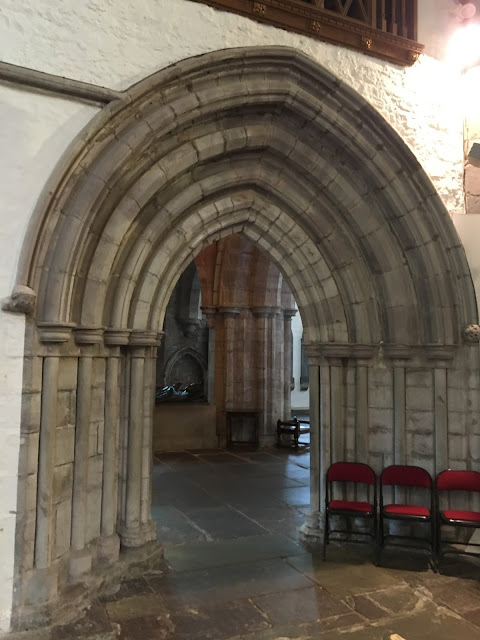The old town has an intricate, and very satisfying pattern of narrow streets lined with mainly Georgian facades. At its centre stands the church of St Mary, which possesses a very fine west tower. Welsh both in its bluntness and the relative smallness of openings; and Somerset in its details.
The cathedral stands above, and to the north of, the town centre. It is a big-boned structure, rubble built with a squat central tower. The whole thing could almost be a geological feature, rather than something made by the hand of man. The interior is spacious, the architecture massive and powerful, seemingly much more ancient than it actually is. Cavernous almost, particularly in the nave where the walls are stripped of plaster. In places one gets a sense of the architecture - the arches and windows - having been sculpted out of a great mass of masonry like it was solid rock.
As at Kidwelly and Abergavenny 'the Church of St John the Evangelist beyond the walls' is an Anglo-Norman foundation, (1093, by Bernard de Neufmarche) and built in close proximity to a castle. A Benedictine house, it was under the temporal and spiritual authority of the Abbey at Battle, Sussex. The font, with its powerful, barbaric carving is the earliest recognizable feature.
The transepts and choir are Early English. The architecture of the nave later still, though it is possible that the rubble walls themselves are much older. At the Reformation the priory was dissolved, the church became parochial and the priory buildings sold to Sir John Price. The transepts are full of memorials from that period as a parish church. Look out in particular for the amazing number of distinctive floor-slabs. George Gilbert Scott senior restored the cathedral in the mid 19th century (1860-75) but his touch was light. His one major visual contribution was the vaulting in the choir. A stroke of genius.
Further restoration was undertaken by W D Caroe and later by his son Alban both of whom worked in an Arts & Crafts idiom. In 1923 it became the cathedral church for a new Anglican diocese - Swansea and Brecon.
















No comments:
Post a Comment